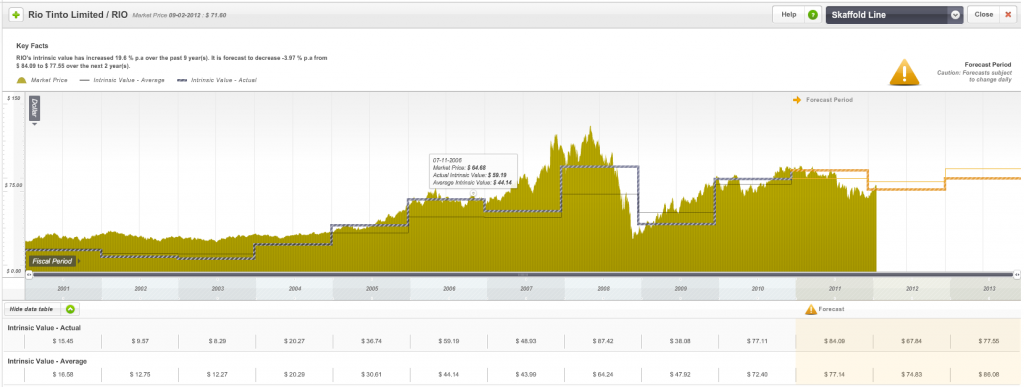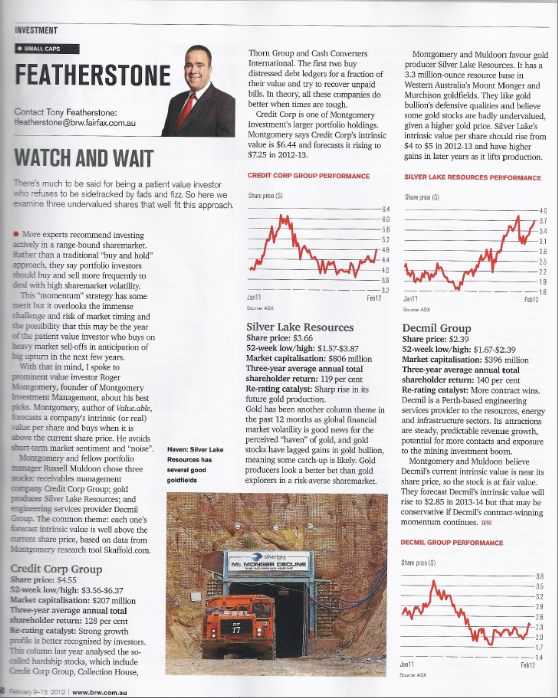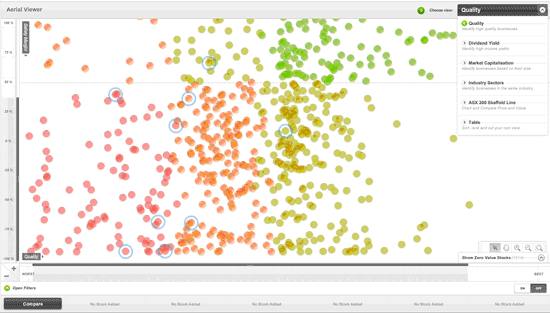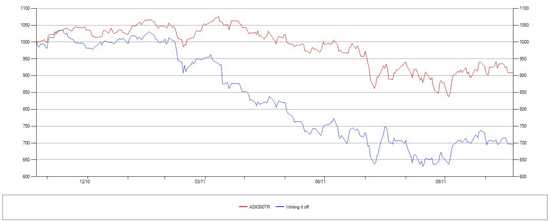Insightful Insights
-

MEDIA
Buying opportunities
Roger Montgomery
February 21, 2012
In his ASX Investor Hour presentation of 21 February 2012, Roger argues that whether you invest on the basis of fundamentals or technical analysis, your buying and selling decisions should always be made in the light of your valuation of the company. Roger explains the factors he takes into account in assessing the value of companies, the systems he uses to do those valuations and talks about some of the companies that he currently regards as good value. Watch video here and view the slides here.
by Roger Montgomery Posted in Insightful Insights, Investing Education, TV Appearances, Value.able.
-
Gold v Stocks; Who will win?
Roger Montgomery
February 14, 2012
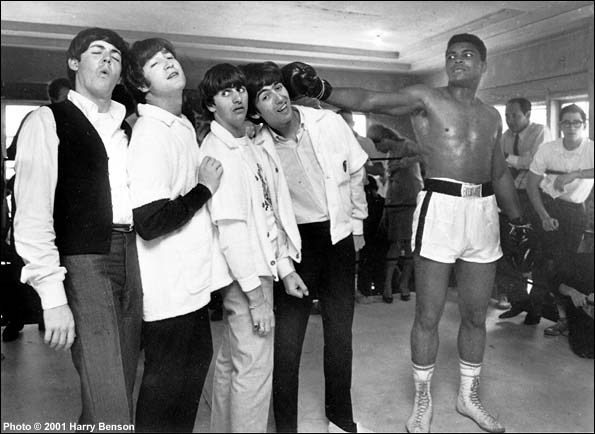 On one side of the investing coin is the idea that you lay out money today to get more back later. The flipside is that buy purchasing today you forego consumption today for the ability to consume more later.
On one side of the investing coin is the idea that you lay out money today to get more back later. The flipside is that buy purchasing today you forego consumption today for the ability to consume more later.They aren’t quite the same thing of course, because the latter idea introduces inflation and suggests the purpose of investing is to at least maintain purchasing power (generate returns in line with inflation) or increase purchasing power (generate real returns in excess of inflation). In a useful reminder Buffett observes:
“Even in the U.S., where the wish for a stable currency is strong, the dollar has fallen a staggering 86% in value since 1965, when I took over management of Berkshire. It takes no less than $7 today to buy what $1 did at that time. Consequently, a tax-free institution would have needed 4.3% interest annually from bond investments over that period to simply maintain its purchasing power. Its managers would have been kidding themselves if they thought of any portion of that interest as “income.””
Therefore an investment that is price stable but loses purchasing power is very risky (think US T-Bonds) while an asset that is volatile in price but almost certain to increase purchasing power over time is less risky than the conventional measures of risk would dictate.
This is how Buffett begins an excerpt of his forthcoming letter to Berkshire Hathaway shareholders HERE. One scenario his introduction does not contemplate of course is deflation. Japanese real estate and equity prices are fractions of their previous levels and a bond offering even a miniscule return would produce an increase in purchasing power. Like many readers, you might reach the conclusion that the absence of this scenario in his letter along with the knowledge of aggressive equity purchases in recent months, indicates he does not believe deflation is a possibility.
The other subject of his letter is Gold. Melted down all the gold in the world would amount to one 68 cubed foot of uselessness. Somewhat ironically he reflects on its purchasing power today – all the agricultural land in the United States, sixteen companies as valuable as Exxon and a trillion dollars in walking-around money.
But he points out that the companies will have thrown off dividends and the land would have produced food. And so the article leads to the defence of buying businesses as a superior strategy (to owning gold ‘that just sits there’) – as we believe at Montgomery Investment Management, and you might as Value.able graduates (after seeking and taking personal professional advice).
I believe Buffett’s take on the investing landscape is ultimately correct (bubbles are always followed by a bust and nothing goes up forever);
“What motivates most gold purchasers is their belief that the ranks of the fearful will grow. During the past decade that belief has proved correct. Beyond that, the rising price has on its own generated additional buying enthusiasm, attracting purchasers who see the rise as validating an investment thesis. As “bandwagon” investors join any party, they create their own truth — for a while.”
But I trust you can see the irony in claiming gold is useless and yet it can buy 16 Exxons and so on. As the chart shows, it has underperformed stocks over the long term and without boasting about it Buffett uses the S&P500 index to demonstrate the superiority of stocks. In a thinly veiled warning to gold bugs he likens the current enthusiasm for gold to the internet bubble and US housing speculation pre-2007.
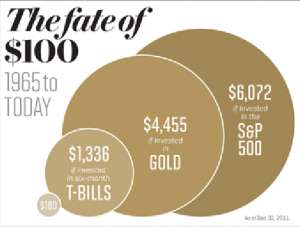 In his enthusiasm for stocks being best able to retain purchasing power or increase it, I can’t but help remembering that Buffett was a more circumspect proponent of stocks in the seventies – a period of very high inflation. While in 1974, when Forbes asked Buffett how he felt about the stock market at the time, Buffett replied, “Like an oversexed guy in a whorehouse”, his 1979 letter to investors serves as a useful reminder of the limits of any asset to retain purchasing power during bouts of high inflation.
In his enthusiasm for stocks being best able to retain purchasing power or increase it, I can’t but help remembering that Buffett was a more circumspect proponent of stocks in the seventies – a period of very high inflation. While in 1974, when Forbes asked Buffett how he felt about the stock market at the time, Buffett replied, “Like an oversexed guy in a whorehouse”, his 1979 letter to investors serves as a useful reminder of the limits of any asset to retain purchasing power during bouts of high inflation.“Just as the original 3% savings bond, a 5% passbook savings account or an 8% U.S. Treasury Note have, in turn, been transformed by inflation into financial instruments that chew up, rather than enhance, purchasing power over their investment lives, a business earning 20% on capital can produce a negative
real return for its owners under inflationary conditions not much more severe than presently prevail.
If we should continue to achieve a 20% compounded gain – not an easy or certain result by any means – and this gain is translated into a corresponding increase in the market value of Berkshire Hathaway stock as it has been over the last fifteen years, your after-tax purchasing power gain is likely to be very close to zero at a 14% inflation rate. Most of the remaining six percentage points will go for income tax any time you wish to convert your twenty percentage points of nominal annual gain into cash.
That combination – the inflation rate plus the percentage of capital that must be paid by the owner to transfer into his own pocket the annual earnings achieved by the business (i.e., ordinary income tax on dividends and capital gains tax on retained earnings) – can be thought of as an “investor’s misery index”. When this index exceeds the rate of return earned on equity by the business, the investor’s purchasing power (real capital) shrinks even though he consumes nothing at all. We have no corporate solution to this problem; high inflation rates will not help us earn higher rates of return on equity.”
Another warning to stick to high ROE businesses…
Finally remember that if you are buying stocks, unlike commodities, there exists management risk, execution risk, result risk, competitor risk, economic risk, currency risk etc. Anything can go wrong in a business and frequently does. And while Chalrie Munger has pointed out that “Almost all good businesses engage in ‘pain today, gain tomorrow’ activities”, you must know what you are doing.
I think stocks are indeed the best opportunity to retain and increase purchasing power but only the good quality ones. Knowing what you are doing and sticking to high rates of return on equity, little or no debt and A1 or A2 businesses increases your chances of doing even better than the both the stock market index of which they are constituents and inflation.
Posted by Roger Montgomery, Value.able and Skaffoldauthor and Fund Manager, 14 February 2012.
by Roger Montgomery Posted in Companies, Insightful Insights, Skaffold.
- 40 Comments
- save this article
- POSTED IN Companies, Insightful Insights, Skaffold
-
Is China exporting inflation now? Did the RBA know? What’s going on at RIO?
Roger Montgomery
February 10, 2012
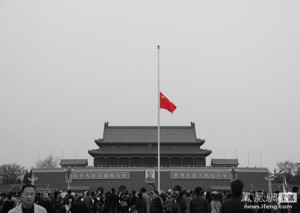 Following on from our comment yesterday about BHP and comments in the media explaining why we weren’t buyers of BHP or RIO (falling Iron Ore prices and a contracted customer (28% of RIO’s revenue last year) who won’t honor contracts), we are interested in the flow of information through the week.
Following on from our comment yesterday about BHP and comments in the media explaining why we weren’t buyers of BHP or RIO (falling Iron Ore prices and a contracted customer (28% of RIO’s revenue last year) who won’t honor contracts), we are interested in the flow of information through the week.First the RBA held off cutting rates. Did they know that China would soon be exporting inflation (cost pressures there)? Then the next day China reported…guess what….the biggest jump in inflation…so forget about rate cuts there to help out US and Euro exports?
And now we are hearing that over at RIO a freeze has been placed on contractors and recruitment. Read; “massive overspend / cost inflation”.
Today Bloomberg quoted an analyst on China: “Domestic demand was genuinely weak in January, while exports remained on a gradual downward trend,” said Yao Wei, a Hong Kong-based economist for Societe Generale SA. And “Tom Albanese, chief executive officer of Rio Tinto Group, said yesterday he remains confident of a so-called soft landing in China… Inflation (CNCPIYOY) accelerated last month for the first time since July as food prices climbed before the holiday that started Jan. 22, a statistics bureau report showed yesterday. An index of export orders in the agency’s survey of manufacturing purchasing managers released last week showed a contraction for the fourth straight month. The IMF said in a Feb. 6 report that China’s economic expansion may be cut almost in half from its 8.2 percent estimate this year if Europe’s debt crisis worsens, a scenario that would warrant “significant” fiscal stimulus from the government.(See my postscript).
17/2/2012 PostScript: An analyst we regard highly wrote this to us today:
“On this recent visit, our wise counselor forecast China’s growth rate will be in therange of 8 to 9% in 2012—assuming no major external shocks. Inflationary pressurewill be lower this year than last, especially in the first half of the year. The inflation ratein China for the entire year will be lower than 4%. Low inflation will allow thegovernment to deregulate prices—water, natural gas, and power.Our trusted counselor believes that export markets cannot be counted on to deliver thegrowth that China needs in 2012. Likewise, domestic consumption, while on the rise as apercentage of GDP, is hard to stimulate quickly. Therefore, the only remaining option to preventChinese economic growth from slowing is for the government to use investment as a stimulus.”“On this recent visit, our wise counselor forecast China’s growth rate will be in therange of 8 to 9% in 2012—assuming no major external shocks. Inflationary pressurewill be lower this year than last, especially in the first half of the year. The inflation ratein China for the entire year will be lower than 4%. Low inflation will allow thegovernment to deregulate prices—water, natural gas, and power.Our trusted counselor believes that export markets cannot be counted on to deliver thegrowth that China needs in 2012. Likewise, domestic consumption, while on the rise as apercentage of GDP, is hard to stimulate quickly. Therefore, the only remaining option to preventChinese economic growth from slowing is for the government to use investment as a stimulus.”
Here’s a quick view from Skaffold of RIO. To become a Skaffold member and enjoy having every stock in the Australian market quality rated and valued and all valuations and data automatically updated for every company every day CLICK HERE
Posted by Roger Montgomery, Value.able and Skaffoldauthor and Fund Manager, 10 February 2012.
by Roger Montgomery Posted in Energy / Resources, Insightful Insights, Manufacturing.
-
The colour of money?
Roger Montgomery
February 9, 2012
 It’s been a lackluster start to this year’s company confession session. Only a few companies have so far bucked the stable / downward trend in revenues and profits.
It’s been a lackluster start to this year’s company confession session. Only a few companies have so far bucked the stable / downward trend in revenues and profits.At the top of this list, reporting what I would consider to be quality results are CCP (SQR A2) – so far the clear standout and a business we own in the Montgomery Private Fund. This is followed by WEB (SQR A2) a business whose Total Transaction Value (TTV) is growing at rates 4x the industry average but is a little expensive in terms of its future prospects for now.
And that’s about it at the quality end of the investment spectrum (with the exception of Breville, Forge and Decmil’s updates). Remember that we rate every single listed company from A1 (the best) to C5 (the worst) so we follow them all. If you want to find opportunities such as CCP before everyone else, take a look at Skaffold.com
There have been a number of other businesses which have reported so far and on face value, while LGD (SQR B2) experienced strong revenue and profit growth; a large proportion of its growth was driven by several recent acquisitions. Organic growth is less than 50% of that being reported currently; something to watch in future reporting seasons.
Now to our friends long Telstra:
(SQR B3) the half year was a little sobering for those who have bought the stock for its dividend yield. Whilst reported Free Cash Flow was $1,795b and dividends paid amounted to $1,738b, one would assume the yield was fully covered. Not so. The free Cash number reported did not include $559m in interest repayments on almost $15b debt. $500m additional debt was borrowed to fund dividends and CAPEX – debt to equity thus increased and is currently 104%. While dividends are being paid, and will probably continue being paid, its just worth noting how they are being funded…
Over at the Big Australian – BHP:
Staying at the big end of town and global diversified mineral and petroleum producer BHP (SQR B1) reported a HY NPAT $9.9b NPAT down on last year’s. The lower results was despite very attractive Iron Ore, Bulks and Petroleum margins – prices which declined in the latter part of 2012 and which may impact profits further in the 2nd half. The acquisition of Petrohawk for $13b (which pushed gearing to 34%) contributed to earnings but couldnt arrest the decline. Industry-wide cost pressures with consumable, labour and contractor costs added $400m to cost inflation! On a more positive note, the project pipeline of $27b and $5b in actual committed projects. In the half total CAPEX (investment) projects + exploration spend was $9b – this continues to support EPC / EPCM engineers, drillers, mud suppliers (Decmil, Forge, Maca, Fleetwood et. al.) which are all operating at full capacity and expanding like there is no tomorrow. However for BHP investors, because the company continuously has to invest in greenfield projects to offset natural production decline, this results in a capital intensive investment program – something investors in BHP 20 years ago might be acutely aware of. Although they have long-life, world class assets and significant cash flows that are able to meet the demands currently, over the past three months profits have been downgraded from circa $25b to circa $19b. Indicative of an economic slowdown and slowing demand for resources. So something to be watchful of is the fact that declining profits = declining cashflows = declining future investment. Albeit the investment future and plans looks like its all boom time right now.
Posted by Russell Muldoon per Montgomery Investment Management, Value.able and Skaffoldauthor and Fund Manager, 9 February 2012.
by Roger Montgomery Posted in Companies, Insightful Insights, Skaffold.
- 5 Comments
- save this article
- POSTED IN Companies, Insightful Insights, Skaffold
-
Does your adviser agree with these stocks?
Roger Montgomery
February 9, 2012
 The ability to pick stocks that never go down, is NOT one of our skills. Plenty of you can attest to that. Value investing using the method we advocate in Value.able and using Skaffold.com cannot prevent losses, it is about minimising the cases of permanent impariment.
The ability to pick stocks that never go down, is NOT one of our skills. Plenty of you can attest to that. Value investing using the method we advocate in Value.able and using Skaffold.com cannot prevent losses, it is about minimising the cases of permanent impariment.Asked by BRW’s Tony Featherstone which small caps we liked we nominated a few. Here’s the list and if you cannot read it properly or would like to also read about the TOP 10 Start Ups of 2011, grab this week’s copy of the BRW.
Remember to seek and take personal professional advice before engaging in any security transactions.
Posted by Roger Montgomery, Value.able and Skaffold author and Fund Manager, 9 February 2012.
by Roger Montgomery Posted in Companies, Energy / Resources, Insightful Insights, Skaffold.
-
First base.
Roger Montgomery
February 6, 2012
 US jobs data was stronger than expected and resulted in global equity markets following the US reaction higher. But is all as it seems?
US jobs data was stronger than expected and resulted in global equity markets following the US reaction higher. But is all as it seems?The increase in jobs was 243,000 but 490,000 were said to be temporary jobs. The employment number is now the same as a decade ago but a decade ago there were 30 million fewer people living in the US!
Charles Biderman notes that “Either there is something massively changed in the income tax collection world, or there is something very, very suspicious about today’s BLS hugely positive number,” adding, “Actual jobs, not seasonally adjusted, are down 2.9 million over the past two months. It is only after seasonal adjustments – made at the sole discretion of the Bureau of Labor Statistics economists – that 2.9 million fewer jobs gets translated into 446,000 new seasonally adjusted jobs.” A 3.3 million “adjustment” solely at the discretion of the BLS? And this from the agency that just admitted it was underestimating the so very critical labor participation rate over the past year? Perhaps with a hint of conspiracy theorist (all hints of which we run from as fast as possible) Biderman wonders whether the BLS is being pressured by the Obama administration during an election year to paint an overly optimistic picture. Hmmmmm…
The BLS however constantly ‘adjust’ its numbers and an January overadjustment occurs annually. Without the BLS smoothing calculation, the real economy lost 2,689,000 jobs, while net of the adjustment, it actually gained 243,000. So are conditions really getting better in the US or only in the adjustment column on an analyst’s spreadsheet?For those of you who have seen the amazing Abbott and Costello skit ‘Who’s on first’, here’s another take on it:
COSTELLO: I want to talk about the unemployment rate in America.
ABBOTT: Good Subject. Terrible Times. It’s 8.3%.
COSTELLO: That many people are out of work?
ABBOTT: No, that’s 16%.
COSTELLO: You just said 8.3%.
ABBOTT: 8.3% Unemployed.
COSTELLO: Right 8.3% out of work.
ABBOTT: No, that’s 16%.
COSTELLO: Okay, so it’s 16% unemployed.
ABBOTT: No, that’s 8.3%…
COSTELLO: WAIT A MINUTE. Is it 8.3% or 16%?
ABBOTT: 8.3% are unemployed. 16% are out of work.
COSTELLO: IF you are out of work you are unemployed.
ABBOTT: No, you can’t count the “Out of Work” as the unemployed. You have to look for work to be unemployed.
COSTELLO: BUT THEY ARE OUT OF WORK!!!
ABBOTT: No, you miss my point.
COSTELLO: What point?
ABBOTT: Someone who doesn’t look for work, can’t be counted with those who look for work. It wouldn’t be fair.
COSTELLO: To who?
ABBOTT: The unemployed.
COSTELLO: But they are ALL out of work.
ABBOTT: No, the unemployed are actively looking for work… Those who are out of work stopped looking.
They gave up and if you give up, you are no longer in the ranks of the unemployed.
COSTELLO: So if you’re off the unemployment rolls, that would count as less unemployment?
ABBOTT: Unemployment would go down. Absolutely!
COSTELLO: The unemployment just goes down because you don’t look for work?
ABBOTT: Absolutely it goes down. That’s how you get to 8.3%. Otherwise it would be 16%. You don’t want to read about 16% unemployment do ya?
COSTELLO: That would be frightening.
ABBOTT: Absolutely.
COSTELLO: Wait, I got a question for you. That means there are two ways to bring down the unemployment number?
ABBOTT: Two ways is correct.
COSTELLO: Unemployment can go down if someone gets a job?
ABBOTT: Correct.
COSTELLO: And unemployment can also go down if you stop looking for a job?
ABBOTT: Bingo.
COSTELLO: So there are two ways to bring unemployment down, and the easier of the two is to just stop looking for work.
ABBOTT: Now you’re thinking like an economist.
COSTELLO: I don’t even know what the I just said!While we are not waiting around for the swallows to sing – then spring will be over – we are buying stocks in a slow and measured way. We haven’t added any new stocks to our portfolio so we are adding to existing holdings.
In Australia, the situation may not be much better. Last year here at the blog we discussed the impending job losses at banks, manufacturers and retailers and all of that appears to be rolling along as predicted. But as my friend Bob Gottliebsen noted today; “At the weekend, Roy Morgan Research reported a big jump in unemployment during January. Almost certainly that will be reflected in the official figures when they are released later this month. Morgan uses a different method to calculate unemployment to the statisticians and Morgan’s December unemployment was 8.6 per cent, compared with the statisticians’ 5.2 per cent. But now Morgan estimates that January unemployment has skyrocketed from 8.6 to 10.3 per cent – the highest level since Morgan began calculating unemployment.”
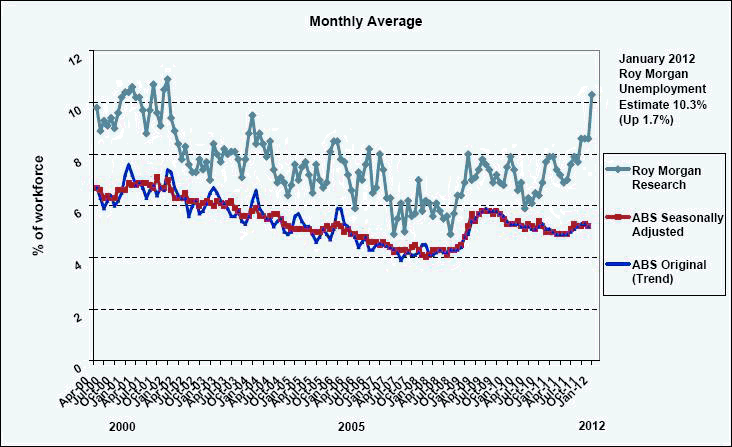 “There is no doubt there are seasonal issues as those leaving tertiary education try to join the labour force. They are usually not employed until February or later months. A rise of the proportion shown by Morgan reflects much greater forces than seasonal influences and in 2012 it will be much harder for students to gain employment than in 2011.”
“There is no doubt there are seasonal issues as those leaving tertiary education try to join the labour force. They are usually not employed until February or later months. A rise of the proportion shown by Morgan reflects much greater forces than seasonal influences and in 2012 it will be much harder for students to gain employment than in 2011.”What does it all mean for value investors – remember, we are not economists and macro economics is not part of the value.able bottom-up approach to investing? The implications are that we should be seeking deeper discounts to intrinsic value estimates and those estimates could decline further.
Given Skaffold (click here to Join) is currently suggesting the ASX200 is not cheap, we tend to be cautious even though my learned peers are betting with the world’s central banks that their printing of money and associated reduction in interest rates will force the world out of being defensively cash weighted and into equities and commodities.
We reckon gold makes sense in these times of destabilised fiat money. As you know we own a number of gold stocks (some of which have returned nearly 100%) and I bought more gold (physical) before Christmas.
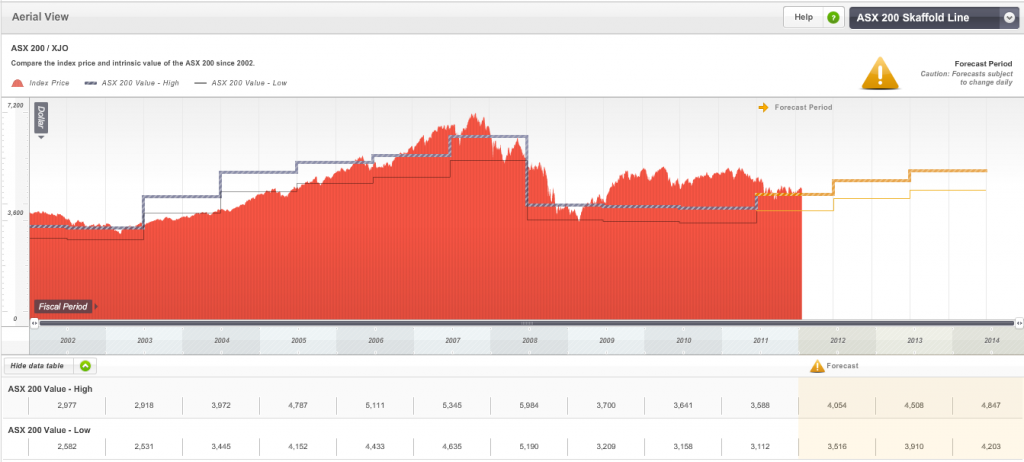 Here is the latest chart of the ASX200 plotted against Skaffold’s estimates of intrinsic value. You can see that the market is trading a little higher than the estimated intrinsic value for the index. That doesn’t mean it can’t go a lot higher, just that if you are a genuine bargain hunter, you may need to be patient. In light of the unemployment situation noted above and the painfully strong Australian dollar, that makes sense.
Here is the latest chart of the ASX200 plotted against Skaffold’s estimates of intrinsic value. You can see that the market is trading a little higher than the estimated intrinsic value for the index. That doesn’t mean it can’t go a lot higher, just that if you are a genuine bargain hunter, you may need to be patient. In light of the unemployment situation noted above and the painfully strong Australian dollar, that makes sense.In addition to the powerful benefit of such a chart as the ASX 200 Skaffold line, which by the way, is automatically keeping you up-to-date daily for changes in analysts estimates of earnings and dividends for each of the 200 indices’ constituents, Skaffold members will enjoy an unprecedented level of interactivity in upcoming updates. By the way, I trust you are enjoying the enhanced search functionality the team delivered last week.
My team noted a few wanna-be competitors trying to plagiarise little aspects of Skaffold recently and I explained that they and you should “be flattered” and I told the team; “if you can see the competition, you aren’t at the front of the race”. Concentrate on staying in front by looking ahead and not at those trying to catch up. They respect Skaffold members too much to insult them by delivering second-hand ideas or technology. Skaffold keeps you in front with world beating ideas – remember the team that works on Skaffold works for Nike, Porsche, EA Games and Google. What possible hope do the competitors have? We’ve retained one of the world’s decorated design and development teams so Skaffold is.
Posted by Roger Montgomery, Value.able and Skaffold author and Fund Manager, 6 February 2012.
by Roger Montgomery Posted in Insightful Insights, Market Valuation, Skaffold.
-
Will Facebook’s IPO be a one day Circus?
Roger Montgomery
February 2, 2012
Unless you live under a waterfall in the rainforests of South America, you will have heard that Facebook has lodged its S-1 (Prospectus) for a probably May 2012 IPO. Skaffold members can look forward to Facebook being available to view in Skaffold when the team loads up all the international stocks.
To become a Skaffold member today and discover how we have been investing click here
Back to our regular programming…
Hyped by the media around the world as the biggest internet IPO in history and asked whether we would ‘invest’ in Facebook, we note the following:
The company already has 500 shareholders and would have been required by the SEC to lodge financials in April.
Facebook Stock Code: FB
Maximum aggregate offering price: $5Bn
as yet, there is not sufficient valuation information listed in the S-1 filing with the SEC nor how many shares are being offered.
According to the S-1 cover:
845 million monthly active users (MAU)
483 million daily active users (DAU)
Users generated on average 2.7 billion Likes and Comments per day in Q4 2011.
100 billion friendships
250 million photos uploaded per day
Our observation: Not a mention of any dollars yet! “likes”, “friends” and ‘uploaded photos’ are today what ‘page impressions’ and ‘visitors’ where in the tech boom of 1999/2000.
FB generated $3.7 billion in Revenue in 2011, up from $2 billion in 2010. 12 percent of Facebook’s revenue in 2011 was linked to its relationship with online gaming giant Zynga.
FB generated $1 billion in net income in 2011, up from $606 billion in 2010, a 40% growth rate, compared to the 165% growth rate from 2009’s $229m.
EBIT margin peaked at 52.3% in 2010 ($1m in EBIT on $2 billion in revenue), has since declined to 47.3% or $1.756Bn on $3.711Bn in Revenue, still incredible.
$3.9 billion in cash and marketable securities
Western world user growth is slowing but thats the law of large numbers. Facebook says: “We believe that our rates of user and revenue growth will decline over time. For example, our annual revenue grew 154% from 2009 to 2010 and 88% from 2010 to 2011. Historically, our user growth has been a primary driver of growth in our revenue. Our user growth and revenue growth rates will inevitably slow as we achieve higher market penetration rates, as our revenue increases to higher levels, and as we experience increased competition.”
The company still reported +60% earnings growth rates in 2011. The key is whether users stay and whether they can be ‘monetized’ further. MAU additions peaked in 2010 when FB added 248m to a total of 608m; in 2011 it added 237MM to 845m.
On the subject of dividends FB says: “We do not intend to pay dividends for the foreseeable future. We have never declared or paid cash dividends on our capital stock. We currently intend to retain any future earnings to finance the operation and expansion of our business, and we do not expect to declare or pay any dividends in the foreseeable future. As a result, you may only receive a return on your investment in our Class A common stock if the market price of our Class A common stock increases. In addition, our credit facility contains restrictions on our ability to pay dividends.”
Here’s access to the S-1: http://www.sec.gov/Archives/edgar/data/1326801/000119312512034517/d287954ds1.htm
The map of the world connected by facebook users is intriguing. What are those pirates on the west coats of Africa doing on Facebook?
I have previously written about the forthcoming floats of internet and social media sites here: http://rogermontgomery.com/which-ipos-are-you-watching/
‘Paradigm changers’ (remember Yahoo?) have come and gone so it is essential you don’t get caught up in the hype and instead stick to the valuation approach that is the bedrock of our approach. If you don’t know it, buy a copy of Value.able today for just $49.95. Or to save yourself reading the last ten annual reports for every listed company, try Skaffold.
There were eight large and highly media-promoted IPOs in the last year or two (GRPN, ZNGA, LNKD, P, YOKU, DANG, AWAY, and FFN). One analyst reported that if you could get stock in the IPO (forget it if you weren’t a major client of the lead broker or a ‘friend’ of the company) there was an average gain of 50%. If you bought each IPO in the market on Day 1 you now have an average loss of 54% with incredibly only 1 of the 8 names (ZNGA) still holding on to gains (+11%) thanks to a rally of 15% in the last week.
We would like to go through the numbers for Facebook today and try to come up with a valuation for you. You can do it yourself if you have a copy of Value.able.
There’s about $5.2 billion in equity, including $1bln of retained earnings. There’s 4.1bln Class A shares and the same number of class B’s. The preferred’s will be converted and only Class A’s sold. We cannot calculate equity per share because the S-1 does not disclose how many shares will be issued. ROE is about 26 per cent. No dividends will be paid. The company states in its S-1 that it will continue to grow by acquisition as well as organically. But the company will takeover Earth if it continues to retain profits and generates 26% returns on the incremental equity. Assuming earnings grow at 40% and faster than the rate of return on equity, then you can expect ROE to rise. Using these favourable metrics we reckon Facebook is worth $26-$28bln in 2012 rising to $57-$63bln in 2014. If the IPO ‘values’ the company at $100bln as many media outlets suggest, watch out.
This paragraph from the S-1 is important:
“If you purchase shares of our Class A common stock in our initial public offering, you will experience substantial and immediate dilution.
If you purchase shares of our Class A common stock in our initial public offering, you will experience substantial and immediate dilution in the pro forma net tangible book value per share of $ per share as of December 31, 2011, based on an assumed initial public offering price of our Class A common stock of $ per share, the midpoint of the price range on the cover page of this prospectus, because the price that you pay will be substantially greater than the pro forma net tangible book value per share of the Class A common stock that you acquire. This dilution is due in large part to the fact that our earlier investors paid substantially less than the initial public offering price when they purchased their shares of our capital stock. You will experience additional dilution upon exercise of options to purchase common stock under our equity incentive plans, upon vesting of RSUs, if we issue restricted stock to our employees under our equity incentive plans, or if we otherwise issue additional shares of our common stock. For more information, see “Dilution”.
Note the blanks, which makes FB impossible to value on a per share basis, yet.
We’ll have to wait until the final days of the capital raising before we can come up with a firm valuation on a per share basis but for now, the circa $27bln valuation stands.
Posted by Roger Montgomery, Value.able and Skaffold author and Fund Manager, 2 February 2012.
by Roger Montgomery Posted in Companies, Insightful Insights, Investing Education, Value.able.
-

MEDIA
Why does Roger Montgomery think 2012 may be our toughest year yet?
Roger Montgomery
February 1, 2012
Roger Montgomery discusses why the global investing outlook for 2012 will be impacted by a variety of negative influences in this Money Magazine article published February 2012. Read here.
by Roger Montgomery Posted in Insightful Insights, Investing Education, Market Valuation, On the Internet, Value.able.
-
Are two lemons better than one?
Roger Montgomery
January 31, 2012
Robert Gottliebsen penned an interesting piece in the Business Spectator today. Using data provided by James Stuart of Ferrier Hodgson that revealed Internet penetration – as a portion of sales for large US retailers – as high as 18% and comparing that to average penetration of online sales from retailers in Australia of 1%, Robert concluded that time is ticking for owners of commercial property.
I agree with Bob’s conclusions. Oroton’s online store is now its biggest store in terms of sales and sagging bricks and mortar retail growth will force many retailers to also move online and embrace the structural change or go the way of the dinosaurs.
Tight margins, expensive staff and exorbitant rents spell trouble for any business that cannot maintain prices in the face of an online and overseas onslaught.
The impact on rents of commercial buildings such as shops will ultimately be negative And on this point I agree with Bob. But we can add one more step to the scenario. Either a new generation of offerings replaces the old school tenants who are departing and rents are maintained or declining rents lead to lower real estate prices which encourages buyers who are both retail operators and store owners rather than tenants.
Incidentally, at Montgomery Investment Management we cannot find a single listed property trust that meets our criteria. If you can find value in the listed property sector do let us know, but we cannot.
I feel for those who bought shops in strips like to Toorak Road, Chapel Street and Oxford Street on capitalisation rates of less than 3% or 4%.
I also feel for fruit and vegetable growers in Australia who are about to find out what grocery suppliers and milk producers have recently experienced. Many farmers have told me of the mere cents per kilo received by them from major supermarkets who in turn sold the same produce at multiples of 10 and 11 times while explaining to farmers that they needed to charge such high multiples to cover the cost of business. The announcement on Today Tonight last night by Coles staffer Greg Davis of 50% cuts in the prices of fruit and vegetables, suggests the real cost of doing business is much lower than what the supermarkets have been telling farmers.
And if they’ve been dishonest with farmers then perhaps it’s a little disingenuous for Greg Davis to say on national television “We’re investing in prices as well, but our growers are working with us to plan our crops, to ensure that we’ve got certain year-round volumes. We buy in such huge volumes, it brings down the cost of the produce, so customers benefit and growers benefit, because we can move stock really quickly”. Do we reallyt need ore food to be produced? It seems Coles would like us to forget just how many thousands of tonnes of fruit and veg is thrown out by each of the supermarkets each year. According to the National Waste Report 2010, food waste constituted 4.5 million tonnes or 35% of municipal waste. When Coles talks about moving more products at lower prices are obviously not referring to us eating it!
Bruno writes in the comments below:
“Hi Roger,
Just a comment on what farmers are getting for their produce. Being a farmer I can tell you that the very most we have received for citrus is 40c per kg, but on average we get about 20c then we must pay 10c of that just to have them picked. My next door neighbor grew onions this year and also received 20c per kg. pumpkins are the same price. Rice is being sold by farmers for 18c per kg. wine grapes are being harvested right now for an average price of about 24c per kg (1kg is the amount of grapes needed for one bottle of wine) most if not all these crops cost about 10c per kg just to harvest! Of course farming is a cyclical business, and sooner or later what us farmers are paid will have to come up, otherwise there won’t be any farmers left. Where I live we are starting to see banks foreclose on farms, the irony is that no one is willing to buy a business that makes no money. So banks are forced to either lend more money, or spend their own cash to run the farms so the property value isn’t destroyed as fruit trees die. While we worry about the Europe crisis effect on the banks balance sheets we have a very big problem much closer to home which, if farmers don’t start to make a profit soon, will most defiantly effect the share values of the banks as bad debts get written off. if my wide went to work at woollies and at the end of the day she was given a bill from her boss for a days work, there’d be outrage. But when farmers are left in that exact situation, politicians and the like tell us “there’s healthy competition in the market place which benefit consumers” maybe in the short term but as more farmers abandon their farms which is happening, the price of all fruit and vege will definitely go up in the medium term as more and more farmers leave their land.”Further, the wholesale buying of arable agricultural land by foreign interests, the decimation of profitable agricultural enterprises due to irrational competition of the major supermarkets and the replacement of their product by foreign alternatives will not ultimately produce the best outcome for Australia.Australians cannot buy freehold land in China and foreigners are banned from owning the ground floor apartment in any building in Singapore so one does wonder whether our generosity is well placed all in the name of pursuing lower prices for short sighted consumers.
Posted by Roger Montgomery, Value.ableauthor and Fund Manager, 31 January 2012.
by Roger Montgomery Posted in Insightful Insights.
- 47 Comments
- save this article
- POSTED IN Insightful Insights
-
Are investors giving up?
Roger Montgomery
December 20, 2011
 We have talked here at the blog about hypothecation, re-hypotecation and hyper-hypothecation, about credit default swaps about a Chinese property bubble bursting, about lower iron ore prices, slower economic growth, increased savings and declining rates of credit expansion and a European sovereign default. Always the value investor, we are on the look out for anything that can impact the values of companies and those things that might offer the prospect of picking up a few bargains.
We have talked here at the blog about hypothecation, re-hypotecation and hyper-hypothecation, about credit default swaps about a Chinese property bubble bursting, about lower iron ore prices, slower economic growth, increased savings and declining rates of credit expansion and a European sovereign default. Always the value investor, we are on the look out for anything that can impact the values of companies and those things that might offer the prospect of picking up a few bargains.If your portfolio still has some rubbish in it, then being able to identify it is a key part of preparing for cheaper prices if they eventuate.
I recently wrote a column for the ASX and pondered the possibility of a climactic event coinciding with a complete throwing in of the towel by equity investors who are simply fed up with poor medium term returns and increased volatility recently.
The ASX200 hasn’t generated a positive capital return since 2005 but quality companies have. The ASX200 contains stocks that are rubbish so it is no wonder that an index based on that rubbish has gone nowhere. Step 1 then is to clean up the portfolio and step 2 is to be ready for quality bargains when they arise.
This is just one of many scenarios and frameworks I am operating with and I wonder what would transpire if the poor returns or the recent heightened volatility continues for a little longer? Will investors simply throw in the towel, leave equities and believe all those advisors offering their own brand of ‘safe’, ‘secure’ and stable investments? On the one hand, I hope so. It would mean certain bargains.
Here’s the Column:
As global sharemarkets decline, remain volatile and produce poor historical returns compared to other asset classes, it will be easy to be swayed by the latest investment trend – to move out of shares. I believe the trend away from shares will gather pace soon as more and more “experts” use the rear-view mirror to demonstrate why sharemarket investors would have been better off somewhere else.
In 1974 US investors had just endured the worst two-year market decline since the early 1930s, the economy entered its second recessionary year and inflation hit 11 per cent as a result of an oil embargo, which drove crude oil prices to record levels. Interest rates on mortgages were in double digits, unemployment was rising, consumer confidence did not exist and many forecasters were talking of a depression.
By August 1979, US magazine BusinessWeek ran a cover story entitled ‘The Death of Equities’ and its experts concluded shares were no longer a good long-term investment.
The article stated: “At least 7 million shareholders have defected from the stockmarket since 1970, leaving equities more than ever the province of giant institutional investors. And now the institutions have been given the go-ahead to shift more of their money from stocks – and bonds – into other investments.”
But be warned. The time to get interested in share investing and make good returns is precisely when everyone else isn’t.
Your own once or twice-in-a-lifetime opportunity may not be that far away and Labor’s promised tax cut on interest earnings may sway even more to give up shares and put their money in a bank, providing the opportunity to obtain even cheaper share prices.
If prices do fall further – and they could – you will need to be ready and will need some cash. The very best returns are made shortly after a capitulation. Cleaning up your portfolio becomes crucial and this article looks at how to do that.
Rule one: Don’t lose money
The key to slowly and successfully building wealth in the sharemarket is to avoid losing money permanently. Sure, good companies will see their shares swing but the poor companies see the downswings more frequently.
Therefore, the easiest way to avoid losing money is to avoid buying weak companies or expensive shares. One of the simplest ways I have avoided losing money this year in The Montgomery [Private] Fund has been to steer clear of low-quality businesses that have announced big writedowns.
These are easy to spot using Skaffold.
Not-so-goodwill
I have often seen companies make large and expensive acquisitions that are followed by writedowns a couple of years later. Writedowns are an admission by the company that they paid too much for an asset.
When Foster’s purchased the Southcorp wine business in 2005 for $3.1 billion, or $4.17 per share, my own valuation of Southcorp was less than a quarter of that amount. Then in 2008 Foster’s wrote down its investment by about $480 million, and then again by another $700 million in January 2009 and a final $1.3 billion in 2010.
When too much is paid for an acquisition, equity goes up but profits do not and you can see that too much was paid because that ratio I have worked so hard to make popular, return on equity (ROE), is low.
These low rates of return are often less than you can get in a bank account, and bank accounts have much lower risk. Over time, if the resultant low rates of return do not improve, it suggests the price the company paid for the acquisition was well and truly on the enthusiastic side and the business’s equity valuation should now be questioned. If return on equity does not improve meaningfully, a large writedown could be in the offing. This will result in losses if you are a shareholder, and you have also paid too much.
Just remember one of the equations I like to share:
Capital raised + acquisition + low rate of return on equity = writedown.When return on equity is very low it suggests the business’s assets are overvalued on the balance sheet. That, in turn, suggests the company has not amortised, written down or depreciated its assets fast enough, which in turn means the historical profits reported by the company could have been overstated.
Scoring bad companies: B4, B5, C4 and below…
These sorts of companies tend to have very low-quality scores and often appear down at the poor end of the market – the left side of the screen shot in Figure 1 below.
Figure 1. The sharemarket in aerial view (Source; Skaffold.com)
Each sphere in Figure 1. represents a listed Australian company and there are more than 2000 of them. The diagram is taken from Skaffold. Their position on the screen can change daily as the price, intrinsic value and quality changes. The best quality companies and those with positive estimated margins of safety (the difference between the company’s intrinsic value and its share price) appear as spheres at the top right.
Companies that are poor quality (I call them B4, C4 and C5 companies, for example) are found on the left of the screen and if they have an estimated negative margin of safety, they are estimated to be expensive and will be located towards the bottom of the screen.
Highlighted with blue rings in Figure 1 are eight of the companies that announced this year’s biggest writedowns. Notice they tend to be at the lower left of the Australian sharemarket, according to my analysis.
If your portfolio contains shares that are red spheres and on the lower left, you could also be at risk because these companies tend to have low-quality ratings and are also possibly very expensive compared to their intrinsic value.
As is clear from Figure 1, this year’s biggest writedown culprits were all already located in the area to avoid.
The impact of owning such a business outright would be horrendous. Table 1 below reveals the size and details of these writedowns and as you can see, collectively the losses to shareholders amount to $4.6 billion.
Table 1. Predictable losses?
Warren Buffett once said that if you were not prepared to own the whole business for 10 years, you should not own a piece of it for 10 minutes.
Clearly you would not want to own businesses that pay too much for acquisitions and subsequently write down those assets. If you are not willing to own the whole business, don’t own the shares. Although in the short run the market is a voting machine and share prices can rise and fall based on popularity, in the long run the market is a weighing machine and share prices will reflect the performance of the business. Time is not the friend of a poor company, and companies Skaffold rates C4 or C5 are best avoided if you want the best chance of avoiding permanent losses.
Look at Figure 2 below. Those big writedown companies not only performed poorly but so did their shares. These companies (shown collectively as an index in the blue line below) produced bigger losses for investors than the poorly performing indices of which they are part. And that’s just over one year.
Figure 2. The biggest writedowns compared to the market
Take a look at the companies in your portfolio. Do they have large amounts of accounting goodwill on their balance sheet as a portion of their equity? Have they issued lots of shares to make acquisitions and are they producing low and single-digit returns on equity? If the answer to all these questions is yes, you may have a C5 company.
Cleaning up your portfolio not only lowers its risk but will produce cash that may just prove handy in coming months.
If you have made it this far then here’s evidence of the giving up I referred to in the column: http://www.smh.com.au/business/investors-turn-to-term-deposits-in-shift-away-from-equities-20111219-1p2ir.html
Posted by Roger Montgomery, Value.able author and Fund Manager, 20 December 2011.
by Roger Montgomery Posted in Companies, Insightful Insights, Market Valuation, Skaffold, Value.able.
